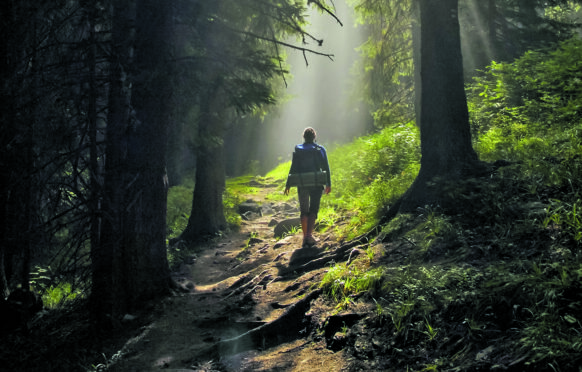
Few exercises come close to the restorative power of walking. After all, by simply lacing up our trainers, and putting one foot in front of the other for as little as 10 minutes, we can stride towards better physical and mental health.
But did you know that as well as providing gentle exercise, regular walking could help with everything from ageing more slowly to sparking creativity in tired minds? In her new book, published earlier this month, author Alice Peck explores how different “ways to walk” can provide numerous benefits, from feeling more connected to nature to easing stress and anxiety.
Here, Peck outlines three walking activities that will inspire you to explore nature – and yourself – one step at a time.
Kinhin walking meditation
The Vietnamese Buddhist teacher and peace activist Thich Nhat Hanh wrote in Present Moment, Wonderful Moment (1990), “The mind can go in a thousand directions. But on this beautiful path, I walk in peace. With each step, a gentle wind blows. With each step, a flower blooms”.
Like exercise, the benefits of meditation are many, and scientists and doctors are always finding new ones, from easing stress to improving focus to facilitating healing on all levels from heart health to immunity. There is a way to combine both exercise and meditation, and you can do it outside in nature, whether that nature is a sylvan glade, a seashore path, or the sidewalk between apartment buildings.
Here is a walking meditation practice based on the zen technique kinhin, which might seem familiar if you have ever intentionally walked a labyrinth. It can be done inside or outdoors, but try for as much fresh air and greenery as possible.
It’s best to plan your route in advance. Knowing your destination means you won’t have to make decisions and can pay attention to each step.
- Stand up straight and take a deep breath.
- Hold your hands in such a way that they don’t swing around but won’t cramp either. I like to fold mine in front of me, the left held in the right.
- Synchronise your breath with your pace. Inhale and step slowly and deliberately, exhale and take another step.
- Begin to walk, paying attention to lifting your foot and placing it on the ground, then lifting your other foot and placing it on the ground.
- Continue to walk in this careful, controlled manner. Don’t force it, but don’t saunter either.
- As with any mindfulness practice, when thoughts arise, look at them and let them go. Don’t ignore, don’t judge..
Forest bathing
Any walk outdoors is good for you, but if you can get to some woods, that’s even better. Over the past few years, more people have become intrigued by the concept of forest bathing – healing through the contemplative practice of intentionally spending time with trees. Here’s a step-by-step, tree-by-tree guide.
- You need only the most basic equipment: Walking shoes and insect repellent. Leave your camera, journal, and guidebooks behind, and turn off your mobile devices. Forest bathing is about being, not analysing.
- Find some trees. This can be a forest of ancient pine or a copse of paper birch, or, if you’re like me, a single silver maple in your backyard. Of course, spending more time with more trees is better, because the effect is multiplied – studies have shown that spending three days and two nights in a thickly wooded area will improve the function of the immune system for up to seven days – but do the best you can. A little forest bathing is better than none.
- Find somewhere to sit or lean, where you can be still for 10 or 20 minutes or more without being in the way of bicycle traffic, ants, or poison ivy.
- Now just be still. Be aware of your breath, but do not force it. Let the experience come to you, don’t analyse. See what you see, hear what you hear, smell what you smell, feel what you feel. Light through the leaves… skittering or birdsong… blossom or decay… calm or grounded…
- As you walk home, check in with yourself. Do you notice any changes in your body? How about your state of mind? What can you take back to your daily life from your forest bathing experience? Do you feel more optimistic? More serene? How is that headache?
- Repeat as often as possible, and pay attention to any improvement in your wellbeing. Try a new spot next time, or focus on another kind of tree, and note the difference. (Having said that, forest bathing with the same trees in the same spot will vary every time, depending on the season, the weather, the time of day, and what you bring to the experience.)
Walking on water
If you’re near a body of water, try walking in it: It’s better exercise than walking on land, because you are working against the water’s resistance. This form of exercise is especially recommended for people with arthritis or limited abilities, for whom swimming laps is not a possibility. Plus, your feet get a nice massage as a bonus!
To fully experience the water’s healing benefits, try taking a dip or a glide, if that’s an option. It’s common knowledge that swimming is great exercise, and so are boating and paddle-boarding. When we’re on a board or in a kayak, not only are we moving our muscles and strengthening our lungs, we’re also applying mental focus to stay upright – improving balance and concentration – and we’re directly connected to the psychological healing of being with water.
Mindful Walking by Alice Peck, CICO Books, £7.99

Enjoy the convenience of having The Sunday Post delivered as a digital ePaper straight to your smartphone, tablet or computer.
Subscribe for only £5.49 a month and enjoy all the benefits of the printed paper as a digital replica.
Subscribe